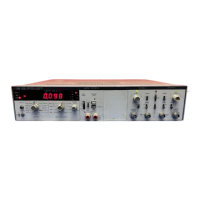Model 5382A
Applications
SECTION
IV
APPLICATIONS
4-1.
INTRODUCTION
4-2. This section contains applications information necessary to obtain the most effective
performance from the 5328A (and options). Specific details and examples are provided for
making measurements of frequency, period, time interval and time interval average, totalizing,
and ratio. Use of the optional DVM's in making measurements
is
included in addition to the use of
the external frequency standard input. Programming information for use with the HP-IB
Interface (Option 011)
is
provided in Section V.
4-3.
FREQUENCY MEASUREMENTS
4-4. To
make a frequency measwemen:
on
a
CW
signal
below
100 ?v.A,Hi,
select
FKEQ
A
function, select the appropriate input signal conditioning (see Paragraph 3-71), and apply the
signal to the A input of the standard or Option 040 universal module. The RESOLUTION switch
determines the resolution of the measurement. Since the 5328A
is
a conventional counter,
1
Hz
resolution
is
obtained in 1 second of measurement time (e.g.,
.I
Hz in 10seconds). The
.I
Hz best
case frequency resolution limits the low frequency measurement accuracy. In practice, low
frequencies are measured by making a period or period average measurement and inverting the
result to obtain frequency.
4-5. To make a frequency measurement on a CW signal in the range of 5-512 MHz (Option
030), select FREQ C function and apply the signal to the Option 030 Channel C input. Make sure
that the amplitude does not exceed 5V rms. The trigger level for the Channel C
is
fixed at OVdc. If
pulse waveforms are being measured, they must cross through 0 volts dc by least 25 mV. Pulse
widths down to 1 ns can be counted.
4-6. The standard and Option 040 universal modules and the Option 030Channel C module are
direct count modules. Direct count allows greater resolution per second of measurement time
than prescaling techniques and
is
important in making frequency measurements on pulse bursts
since the allowable measurement time
is
fixed (must be less than the width of the burst).
4-7.
When the 5328A is in FREQ A or FREQ C function and the rear panel ARM switch
is
OFF, a
measurement cycle
is
initiated (i.e., arms the counter) upon the first trigger level crossing at the A
(or C) input. This means that pulsed signals are measured as easily as CW if the measurement time
(determined by the RESOLUTION switch)
is
less than the width of the pulse.
4-8. With the ARM switch ON, FREQ A and FREQ Care armed by a trigger event at the B input.
This mode
is
useful whenever it is desired to have real time control over when a measurement
is
to
begin. Useful applications include measuring frequency variations along a frequency burst and
linearity testing of sweep generators. Figure 4-1 illustrates the set-up for measuring the linearity
of a sweep generator. The Channel B Trigger level
is
adjusted to trigger (and thereby arm the
counter) at various points along the sweep out waveform. By plotting the B trigger levels (use the
Option 020 or 021 DVM) and the corresponding frequency measurements made at those levels,
the linearity of the generator may be determined.
4-9.
PERIOD MEASUREMENTS
4-10.
The PERIOD and PERIOD AVG functions allow single period measurements or multiple
period averages to be made on input signals into Channel A for frequencies upto10MHz.These
modesare useful for making low frequency measurements where maximum resolution isdesired.
Artisan Technology Group - Quality Instrumentation ... Guaranteed | (888) 88-SOURCE | www.artisantg.com

